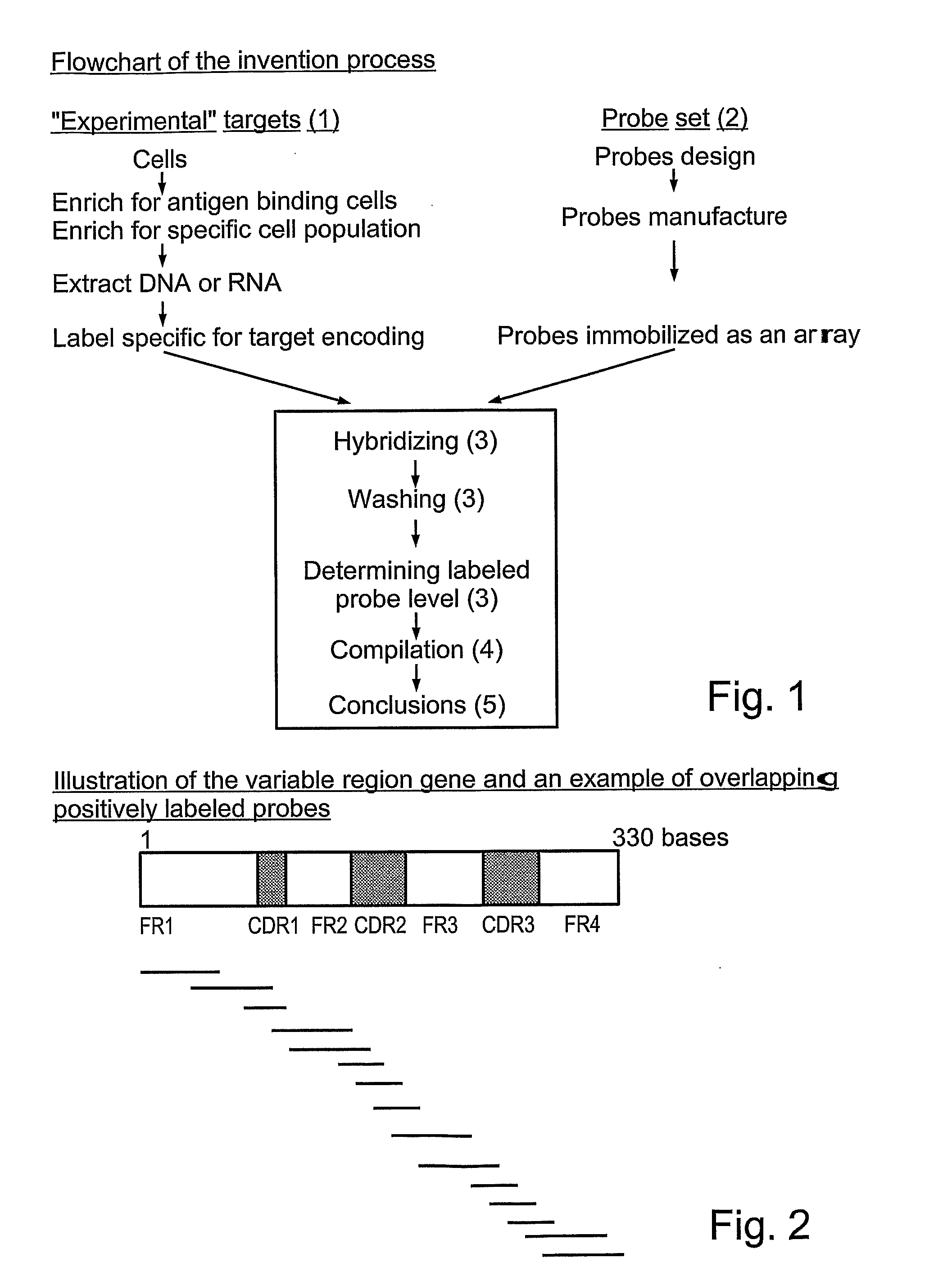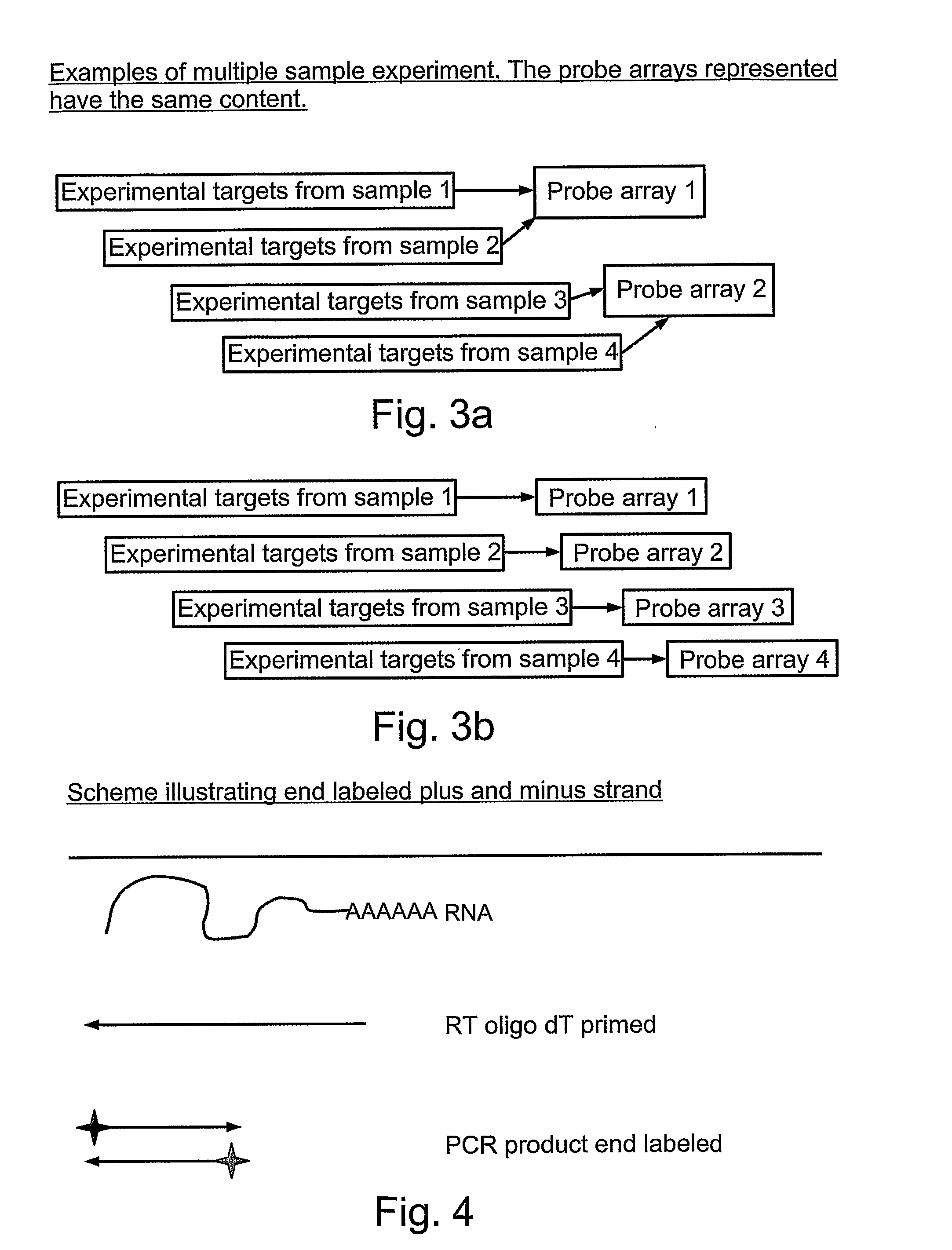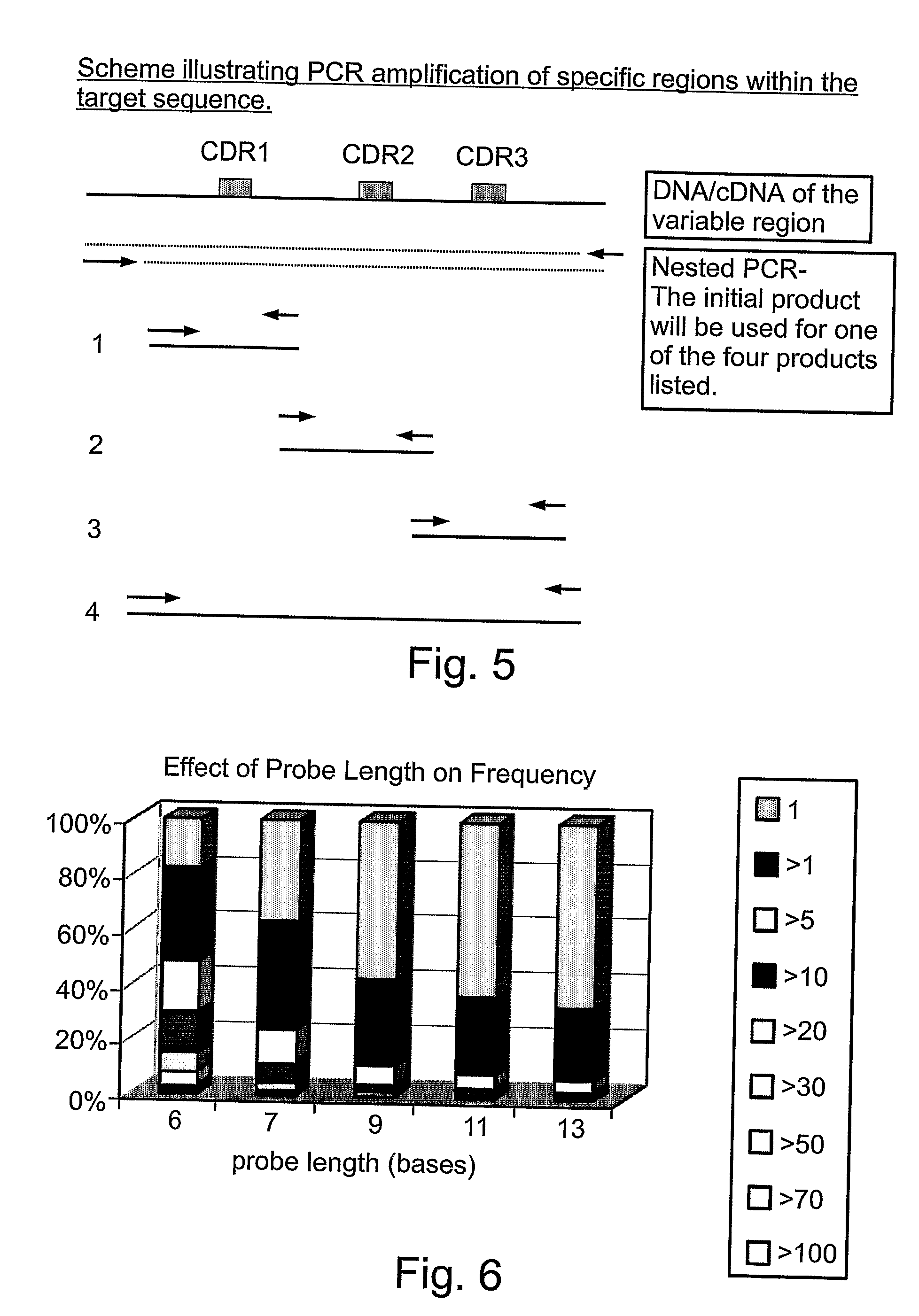Quantifying and profiling antibody and t cell receptor gene expression
a technology of t cell receptor and gene expression, which is applied in the field of sequencing of expressed genes, can solve the problems of no optimal medical management method available, society is confronted with the challenge of vaccinating, and serious complications
- Summary
- Abstract
- Description
- Claims
- Application Information
AI Technical Summary
Benefits of technology
Problems solved by technology
Method used
Image
Examples
example 1
[0178]
TABLE 1All Possible Oligos Derived from HumanGene Fragment VH1-18 (Base 1 to 12)Containing Zero-OneMutationsStart# MutationsSEQGeneposition(position inIDfragmentin geneoligo,type)NO:Oligo sequenceVH1-181019CAGGTTCAGCTGVH1-1811 (1, c -> g)20gAGGTTCAGCTGVH1-1811 (1, c -> a)21aAGGTTCAGCTGVH1-1811 (1, c -> t)22tAGGTTCAGCTGVH1-1811 (2, a -> c)23CcGGTTCAGCTGVH1-1811 (2, a -> g)24CgGGTTCAGCTGVH1-1811 (2, a -> t)25CtGGTTCAGCTGVH1-1811 (3, g -> e)26CAcGTTCAGCTGVH1-1811 (3, g -> a)27CAaGTTCAGCTGVH1-1811 (3, g -> t)28CAtGTTCAGCTGVH1-1811 (4, g -> c)29CAGcTTCAGCTGVH1-1811 (4, g -> a)30CAGaTTCAGCTGVH1-1811 (4, g -> t)31CAGtTTCAGCTGVH1-1811 (5, t -> a)32CAGGaTCAGCTGVH1-1811 (5, t -> c)33CAGGcTCAGCTGVH1-1811 (5, t -> g)34CAGGgTCAGCTGVH1-1811 (6, t -> a)35CAGGTaCAGCTGVH1-1811 (6, t -> c)36CAGGTcCAGCTGVH1-1811 (6, t -> g)37CAGGTgCAGCTGVH1-181VH1-1811 (7, c -> a)38CAGGTTaAGCTGVH1-1811 (7, c -> t)39CAGGTTtAGCTGVH1-1811 (7, c -> g)40CAGGTTgAGCTGVH1-1811 (8, a -> t)41CAGGTTCtGCTGVH1-1811 (8, a -> ...
example 2
[0179]
TABLE 2Table 2: Representation of the Ig Heavy Chain Gene SegmentsOne variable germline gene fragment (out of the 51 genes)recombines with one D (out of 27) and then with one J genesegment (out of 6). N (0-15) random bases are insertedin the junctions between the segments. The gene fragmentsindicated by bold represent a certain recombination eventjoining VH1, 1-03 with D2, 2-21 and JH4 (V-(N)-D-(N)-J).SubSubSub#FamilyLocusFamilyLocusFamily1VH11-02D11-1JH12VH11-03D11-7JH23VH11-08D11-14JH34VH11-18D11-20JH45VH11-24D11-26JH56VH11-45D22-2JH67VH11-46D22-88VH11-58D22-159VH11-69D22-2110VH11-eD33-311VH11-fD33-912VH22-05D33-1013VH22-26D33-1614VH22-70D33-2215VH33-07D44-416VH33-09D44-1117VH33-11D44-1718VH33-13D44-2319VH33-15D55-520VH33-20D55-1221VH33-21D55-1822VH33-23D55-2423VH33-30D66-624VH33-30.3D66-1325VH33-30.5D66-1926VH33-33D66-2527VH33-43D77-2728VH33-4829VH33-4930VH33-5331VH33-6432VH33-6633VH33-7234VH33-7335VH33-7436VH33-d37VH34-0438VH44-2839VH44-30.140VH44-30.241VH44-30.442VH44-314...
example 3
[0180]
TABLE 3Scoring the Various Sequence Assembly OptionsSEQScoreScoreIDDataDataSequenceNO:12aVH4-61CTCCGTCAGCAGTGGTGGTTACTA561010(baseCTGGAGC81-111)bCTCCATCAGCAGTAGTAGTTACTAC57100 30TGGGGCcCTCCGTCAGCAGTAGTAGTTACTA5830100CTGGAGC
[0181] The example in Table 3 above illustrates how to decide which of the sequences coexist in the sample. If the triple mutation (mutation 1 and 2) scores higher than the double one then it is mostly likely that it is the only predominate one (Data 1)., However, if the double mutation scores higher than it is most likely to be the only predominate one (Data 2). Using oligos of length 10 bases and higher will result in better discrimination.
PUM
| Property | Measurement | Unit |
|---|---|---|
| Fraction | aaaaa | aaaaa |
| Fraction | aaaaa | aaaaa |
| Fraction | aaaaa | aaaaa |
Abstract
Description
Claims
Application Information
 Login to View More
Login to View More - R&D
- Intellectual Property
- Life Sciences
- Materials
- Tech Scout
- Unparalleled Data Quality
- Higher Quality Content
- 60% Fewer Hallucinations
Browse by: Latest US Patents, China's latest patents, Technical Efficacy Thesaurus, Application Domain, Technology Topic, Popular Technical Reports.
© 2025 PatSnap. All rights reserved.Legal|Privacy policy|Modern Slavery Act Transparency Statement|Sitemap|About US| Contact US: help@patsnap.com



